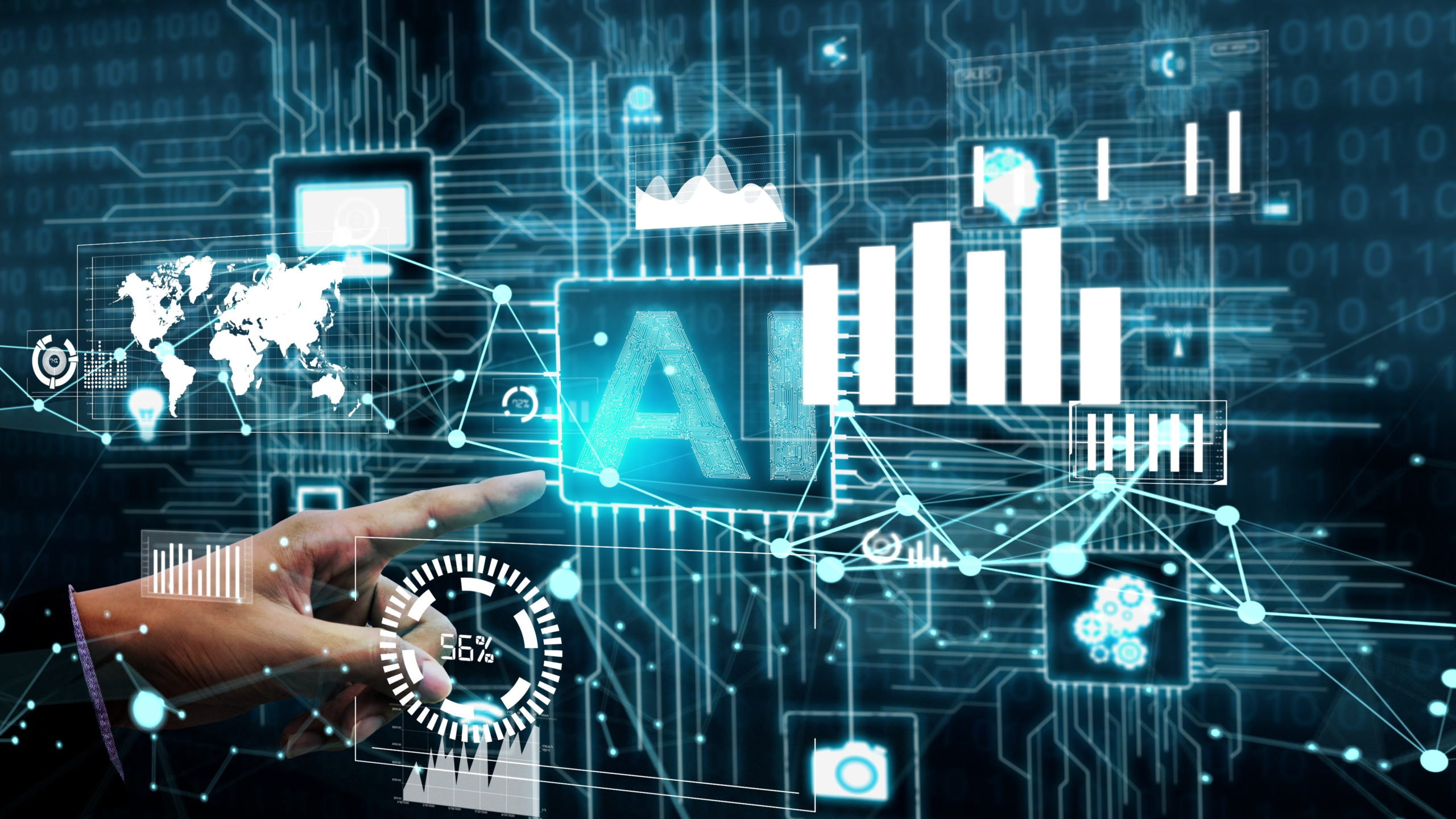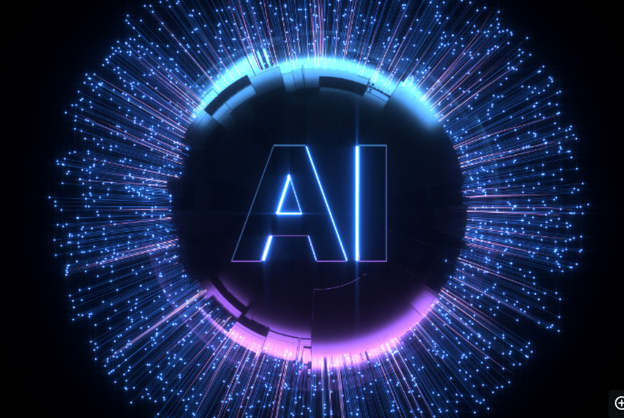As a CEO or leader, you keep hearing how artificial intelligence (AI) will be transformative. But between the hype and reality of AI, it takes time to grasp what AI really means and how to adopt it strategically.
This guide cuts through the noise to offer concise explanations and strategic guidance so you’ll have a clearer picture of AI and its capabilities.
We’ll break down key AI applications and include a quick implementation roadmap to assist your efforts.
Artificial intelligence has the potential to be as big a game changer as the personal computer and the internet for small to mid-sized organizations. But if only understood and used effectively.
Let’s start with a clear explanation and brief history of Artificial Intelligence and its capabilities for your organization.
How Does Artificial Intelligence (AI) Work?
 Artificial Intelligence, or AI, at its core, is a field of computer science that seeks to create machines that mimic human intelligence – this could be anything from recognizing speech to learning, planning, problem-solving, or even perception.
Artificial Intelligence, or AI, at its core, is a field of computer science that seeks to create machines that mimic human intelligence – this could be anything from recognizing speech to learning, planning, problem-solving, or even perception.
In simpler terms, think of AI as a tool or a system that can analyze information, learn from it, and then use that knowledge to achieve specific tasks more efficiently than a human could.
The power of AI comes from its ability to process massive amounts of data at incredible speed, enabling it to recognize patterns and make decisions based on those patterns.
Artificial intelligence already influences many areas of life, from the way we shop online, where it provides product recommendations based on our buying habits, to how our emails are filtered, where it distinguishes between spam and important messages.
For small and midsize organizations, the implications are significant. AI can help automate routine tasks, analyze customer behavior to optimize marketing strategies, improve decision-making with predictive analytics, and more.
When used right, it’s a tool that can give your business an edge in a competitive market. But like any tool, it’s essential to understand its capabilities, limitations, and ethical implications.
AI is not just a futuristic concept or a buzzword – it’s a real, practical technology that is increasingly becoming a part of our daily lives and the operations of businesses of all sizes.
A Brief History of Artificial Intelligence

Artificial Intelligence (AI) has a surprisingly long history, filled with incredible advancements, disillusionments, and ultimately the realization of many of its early promises.
The Birth of AI (1950s-1960s):
The concept of AI was first formally proposed at the Dartmouth Conference in 1956. Early AI, pioneers like John McCarthy and Alan Turing, were optimistic, envisioning a future where machines could mimic human intelligence. However, the technology needed to be more sophisticated to make this a reality.
AI Winter (1970s-1980s):
After the initial excitement, the limitations of the early AI systems became apparent. The lack of computational power, data, and advanced algorithms led to disappointment, resulting in reduced funding and interest in AI research, a period now known as the “AI Winter.”
The Renaissance (1990s-2000s):
A shift towards using statistical models and increased computing power led to a revival of interest in AI. These so-called “Machine Learning” techniques were more practical and found applications in areas like speech recognition and data mining.
AI Spring (2010s-Present):
The 2010s saw the dawn of the “AI Spring,” thanks to the rise of “Deep Learning.” Deep Learning, a subset of machine learning, uses artificial neural networks to model and understand complex patterns.
The availability of big data and powerful computing resources (like GPUs and cloud computing) enabled these neural networks to reach unprecedented performance levels.
The Era of Conversational AI (2020s – Present):
Recent years have ushered in a new era of AI with a special focus on natural language understanding and generation.
Introducing transformative models like ChatGPT by OpenAI has renewed excitement and interest in AI. These models have shown a remarkable ability to understand context, generate human-like text, and engage in meaningful conversation.
Exponential Advances in Computing and the Internet
The 21st-century AI revolution began as exponential advances in computing and the Internet unleashed an explosion of digital data.
With abundant information to feed on, machine learning models, including neural networks, could finally realize their potential. AI went from beating chess masters to powering billion-dollar industries. But most systems were confined to narrow tasks.
Why The explosion of interest in Artificial Intelligence with the intro of ChatGPT?
 ChatGPT, developed by OpenAI, is an AI model based on the powerful GPT-3 (Generative Pre-trained Transformer 3).
ChatGPT, developed by OpenAI, is an AI model based on the powerful GPT-3 (Generative Pre-trained Transformer 3).
What made ChatGPT a game changer was its ability to generate human-like text that is remarkably coherent, relevant, and diverse. Before ChatGPT, AI-generated text often lacked context, sounded robotic, and sometimes veered into nonsensical tangents.
However, ChatGPT showcased an impressive ability to generate fluent, contextually aware responses, making interactions with the AI feel much more like conversing with a human.
The arrival of ChatGPT brought a fresh wave of attention to the field of AI because it showcased the possibilities of what AI could achieve.
Businesses saw how this technology could be used for practical applications like drafting emails, writing code, creating written content, answering customer queries, tutoring various subjects, translating languages, and much more.
The success of ChatGPT underscored the potential of AI as a game-changing tool for businesses, spurring increased interest and investment in AI technologies. It demonstrated that AI could be more than a tool for simple tasks and computations – it could be a partner in complex creative and communicative endeavors.
Why AI Matters: Tangible Benefits for CEOs

Some CEOs and leaders still view AI as a futuristic technology with limited applications.
However, many SMBs are already unlocking immense value from pragmatic AI adoption.
Top benefits of AI include:
1. Competitive Advantage
In an increasingly competitive business landscape, AI can be a game-changer. Companies that leverage AI can analyze vast amounts of data, spot trends, and make strategic decisions faster and more accurately than those that don’t.
AI can also enable new business models or services that set your company apart. Whether through personalized marketing, improved customer service, or innovative products, AI can give your organization an edge over competitors.
2. Efficiency and Productivity Gains
AI can automate routine tasks, freeing up your employees to focus on more complex and value-adding work. Whether it’s an AI chatbot handling common customer inquiries or an AI tool that automates data entry, the potential for increased efficiency and productivity is significant. Moreover, AI can operate 24/7, ensuring tasks are done faster and without human error.
3. Cost Savings
While implementing AI requires an initial investment, the cost savings over the long term can be substantial. Automation of routine tasks reduces labor costs, while improved efficiency can mean faster turnaround times and lower operational costs.
Moreover, the predictive capabilities of AI can help avoid costly errors or delays. For example, AI can predict equipment failures in manufacturing before they happen, preventing expensive downtime.
4. Improved Decision Making
AI excels at analyzing vast amounts of data and uncovering trends and insights that human analysts might miss. This can lead to better decision-making, as decisions are based on hard data and sophisticated analysis rather than gut feeling.
Whether it’s deciding which products to stock, which markets to enter, or how to price your services, AI can provide the insights you need to make smarter, data-driven decisions.
In today’s digital era, AI isn’t a luxury—it’s a necessity. Embracing AI can transform your organization, providing a significant edge in the marketplace, enhancing efficiency, reducing costs, and informing strategic decisions.
As a CEO, understanding AI and its potential impacts is essential to guiding your organization into the future.
Has there been a recent breakthrough in Artificial Intelligence?
Surprisingly, not really, even though it feels that way. When ChatGPT came out, a ton of excitement and hype was created. But truthfully, it represents an incremental advancement rather than a real technological breakthrough.
There are a few key reasons why it felt so groundbreaking with ChatGPT:
- Accessibility – ChatGPT is free and accessible via a simple web interface. This allowed the public to easily experiment with an advanced, conversational AI system firsthand. Prior AI was mostly abstract or required technical know-how.
- Capabilities – ChatGPT handles various natural language tasks and topics. While not perfect, its human-like abilities to generate text surpassed many people’s expectations of what current AI can do. The magic of the black box captivated users.
- Timing – ChatGPT arrived when language AI was already advancing rapidly. Foundation models like GPT-3 primed the public for a leap forward. The pandemic also left people eager for new distractions.
- Watercooler Effect– Viral social media reactions created massive hype and attention around ChatGPT’s launch. This cycle amplified its perceived novelty beyond the reality of incremental progress.
- Promise of Progress – ChatGPT signified the pace of advancement in language AI, capturing the public imagination regarding the possibilities on the horizon. It felt like a preview of the future.
While not a true breakthrough, ChatGPT captured the public imagination through accessible advanced capabilities, strategic timing, hype, and humanlike interaction.
What is Artificial General Intelligence (AGI): The AI Everyone is Concerned About?

General Human-Level AI, also known as Artificial General Intelligence (AGI), refers to a type of artificial intelligence that can perform any intellectual task that a human being can do.
This implies that the machine understands the world comparable to human consciousness and can learn, comprehend, and apply knowledge in various activities, matching human cognitive abilities.
If you have watched the news, there is considerable debate and hype among researchers and AI experts about when AGI might be realized.
Predictions range from a few decades to over a century, or even never, depending on whom you ask.
What are the Ethical Implications of Artificial Intelligence?
-
Bias and fairness:
AI models are trained on data that may contain biases, leading to unfair outcomes when these models are used to make decisions. For example, an AI model used in hiring could inadvertently discriminate against certain demographic groups if the data it was trained on included biased hiring practices.
-
Privacy and surveillance:
AI technologies like facial recognition can invade privacy and enable mass surveillance. These uses raise serious ethical concerns, particularly when deployed by authoritarian regimes or used without individuals’ consent.
-
Transparency
AI can make decisions in difficult or impossible ways for humans to understand, particularly in the case of complex machine-learning models. This lack of transparency makes it difficult to hold AI systems accountable and ensure they make fair and appropriate decisions.
-
Job displacement and economic inequality:
AI has the potential to automate certain jobs, leading to job displacement for those in affected roles. This can exacerbate economic inequality if the benefits of AI are not distributed widely.
-
Security and malicious use:

AI can be used to facilitate cyberattacks, disinformation campaigns, and other harmful activities. For instance, deepfakes generated by AI can be used to create fake news or other forms of deception.
-
Artificial General Intelligence (AGI):
The potential development of AGI, AI with human-like capabilities, raises profound ethical questions. How do we ensure that an AGI system’s goals align with ours? How do we prevent the malicious use of such powerful technology?
As AI evolves, policymakers, technologists, and society must engage in ongoing discussions about these ethical issues and work together to develop appropriate guidelines, regulations, and norms for AI use.
What Tech is Involved in Artificial Intelligence Now?
While the technical details may be complex, it helps to have a high-level grasp of the key capabilities and techniques underpinning today’s AI:
Machine Learning (ML):
This is the backbone of AI. ML enables machines to learn from data, identify patterns, and make decisions with minimal human intervention. It includes techniques like supervised, unsupervised, and reinforcement learning.
Deep Learning:
The human brain inspires a subset of ML and deep learning models and consists of artificial neural networks with multiple layers (“deep” structures). They can learn from unstructured data and are used for complex tasks such as image and speech recognition.
Natural Language Processing (NLP):
NLP allows machines to understand, generate, and respond to human language. This capability is critical in voice assistants, chatbots, and tools that analyze sentiment or extract information from written or spoken language.
Computer Vision:
This capability enables machines to interpret and understand the visual world. It’s used in facial recognition systems, autonomous vehicles, image editing software, and more.
Neural Networks:
These are algorithms designed to recognize patterns similar to how the human brain operates. They interpret sensory data, allowing machines to identify and analyze complex patterns and structures.
Neural Networks are particularly useful in applications requiring image and speech recognition.
Robotic Process Automation (RPA):
RPA uses AI to automate repetitive tasks that humans previously performed. This includes tasks like data entry, transaction processing, and responding to simple customer service queries.
Understanding these fundamental technologies gives you a clearer view of how AI can be integrated into your business operations.
Successful AI implementation is more than the technology and finding the right fit for your organization’s needs and strategies.
Artificial Intelligence Applications for Your Organization

Now that we’ve demystified the core techniques behind AI, where can it generate value for you?
Here are the top business applications and use cases to consider:
- Customer Service Automation
AI-powered chatbots and virtual assistants can handle repetitive customer queries, freeing your human staff to deal with more complex customer issues. This leads to faster response times and higher customer satisfaction.
- Predictive Analytics
Artificial Intelligence can analyze historical data and identify patterns to predict future trends. This can be used to forecast sales, manage inventory, and even predict customer behavior to tailor marketing efforts better.
- Marketing Personalization
AI can help SMBs personalize their marketing efforts by analyzing customer data and preferences. This can include personalized product recommendations, tailored email marketing campaigns, or targeted social media advertising.
- Process Automation
Robotic Process Automation (RPA), powered by AI, can automate repetitive tasks such as data entry, accounting processes, or even some HR functions. This can save time and reduce errors, allowing your staff to focus on more strategic tasks.
- Talent Acquisition and Management
AI can help screen resumes and identify the best candidates for a job based on specified criteria. It can also assist in employee performance analysis and personalized training programs.
-
Cybersecurity

AI can bolster your business’s cybersecurity by identifying unusual activities or behaviors that may indicate a security breach. This allows for quicker response times and more effective mitigation of cyber threats.
- Sales Optimization
It can analyze customer data to identify sales opportunities, recommend up-selling or cross-selling opportunities, and even automate some aspects of the sales process. This can lead to increased sales and revenue.
- Supply Chain Management
Artificial Intelligence can optimize your supply chain by forecasting demand, planning inventory, and identifying potential issues before they become serious problems. This leads to more efficient operations and cost savings.
- Generative AI for Content Creation
Generative AI refers to AI models that can create new content based on the data they’ve been trained on. These include creating written content, designing graphics, composing music, or generating new product designs.
For SMBs, generative AI has several potential applications:
- Chatbots
- Content Generation
- Personalized Marketing
- Product Development
- Virtual Reality
As with any AI technology, the effective use of generative AI requires a good understanding of the technology’s capabilities and limitations and a strategy for best supporting the business’s goals.
Creating An Artificial Intelligence Roadmap

1. Consider your strategy first.
Instead of looking for ways to bring AI into your business, look for ways to use AI to execute your business strategy.
You can’t bolt on artificial intelligence and machine learning, “You have to look at your strategy and say, ‘How can the vendors I work with help me do the strategic things that will help me grow?
How do I use these applications to execute my strategy successfully?’” Identify the yes/no questions that are important to your business.
2. Identify Problem Areas:
Rather than chasing AI for its own sake, start by auditing pain points and processes that reduce efficiency. Let use cases derive from tangible needs.
3. Assess Data Readiness:
AI depends on quality, unbiased data. Assess your data infrastructure and readiness. Clean and consolidate data where needed.
4. Start with Pilots and Quick Wins:
Run controlled pilots with measurable targets focused on high-ROI applications like automation. Don’t boil the ocean early on.
5. Measure Results:
Define key performance indicators for each use case. Measure against baselines to determine ROI and guide expansion decisions.
6. Instill Responsible AI Practices:
Govern and monitor AI for transparency, explainability, accountability, and ethical outcomes. Make fairness a priority.
7. Enable and Upskill Staff:
Foster understanding of AI through training. Empower staff to identify use cases. Upskill data talent needed for oversight.
8. Work with AI Partners Mindfully
Vendors can provide expertise and efficiency. But ensure you control your data and that the AI fits your needs and values.
The Future of AI

While today’s AI capabilities may seem modest, rapid advances are on the horizon that will further reshape our organizations:
- Algorithms will continue to become more accurate at mimicking human learning and decision patterns. This expands use cases.
- Computer vision AI will better analyze images, video, and sensory inputs, enabling more automation of inspections and surveillance.
- Natural language AI capabilities will approach human effectiveness in reading, writing, summarizing, and translating.
- Robotics will surpass human capabilities in some physical tasks with advances in mechanical designs and AI integration.
Exciting? Absolutely. However, the future remains collaborative, with AI augmenting rather than replacing human intelligence and skills.
As leaders, our opportunity is to actively direct this augmentation where it can best serve our organizations and the public.
Conclusion
AI can drive immense value by automating repetitive work, optimizing complex decisions, and enabling new data-driven business models.
But thoughtful strategy, use-case-driven adoption, strong ethics, and wise partnerships are key to actualizing its potential, not hype.
AI marks a paradigm shift on par with prior generational innovations like computers and the Internet. But its responsible adoption requires leadership savvy, not just technical chops.
So, stay pragmatic, start small to build trust, and tap partners to move fast. But most of all, stay human-centered as you integrate artificial intelligence. Your people and customers will appreciate automation and personalization done thoughtfully.
But they will also recoil if AI is implemented crudely in ways that dehumanize experiences. With ethics and vision, however, you can prosper in the age of AI.
NEXT STEPS:
If you would like to learn more about our Managed IT Services, please click on this link below:
Imagine IT
Or if you would like to dig deeper into AI, please check out this additional insights:




